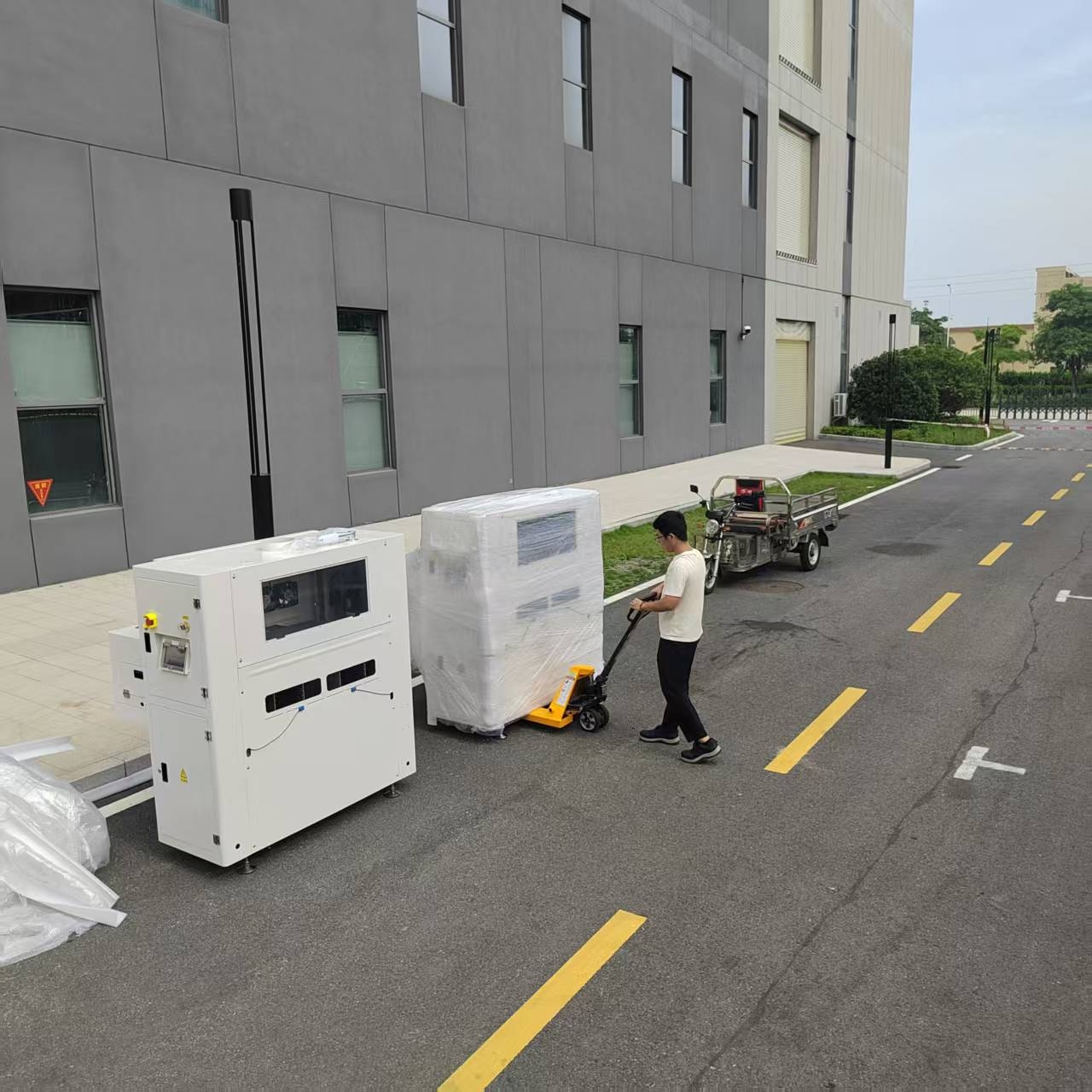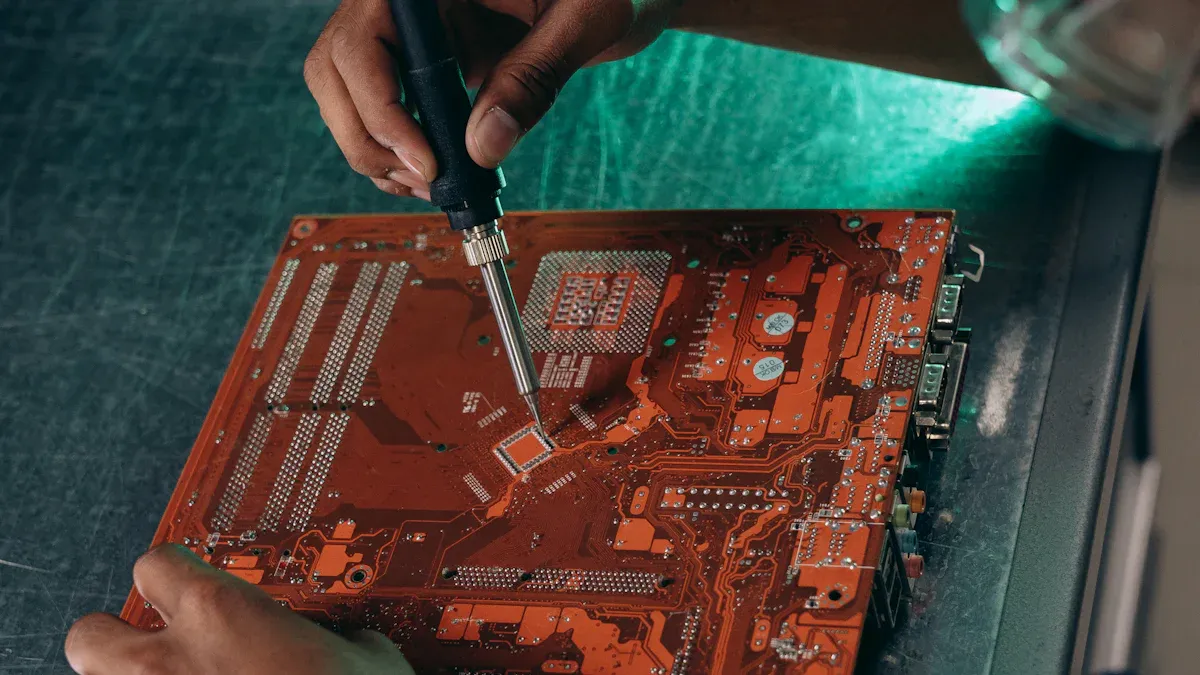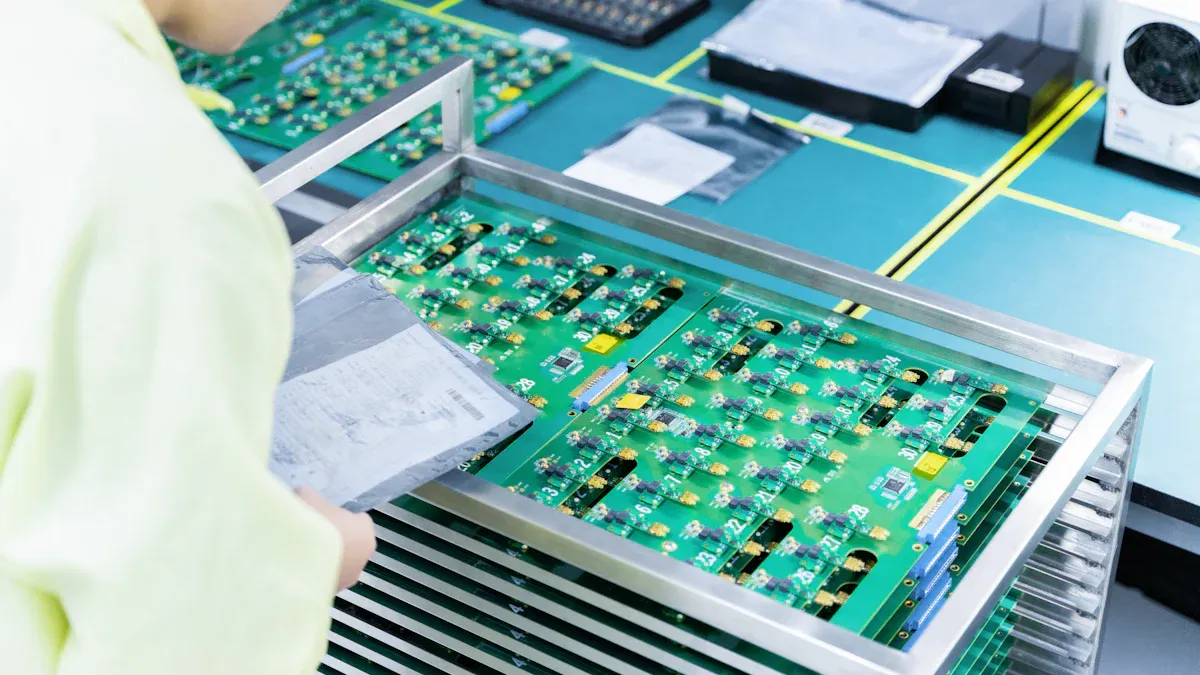
Regular maintenance keeps your PCB conveyor running smoothly and extends its service life. You can reduce downtime by 15-20% with consistent daily care, as shown below:
|
Maintenance Frequency |
Downtime Reduction |
|---|---|
|
Regular Maintenance |
|
|
No Maintenance |
Higher downtime |
Follow these Daily Maintenance Tips to get the best results:
-
Inspect and adjust belt tension and tracking to avoid slippage.
-
Check gearbox oil levels for proper lubrication.
-
Look for wear and misalignment to catch issues early.
-
Keep the conveyor clean and free of dust or debris.
Key Takeaways
-
Regular maintenance can reduce downtime by 15-20%. Make daily checks a priority to keep your conveyor running smoothly.
-
Perform thorough visual inspections each day. Look for wear, damage, or loose parts to catch issues early.
-
Keep your conveyor clean by removing debris and buildup on a daily basis. This prevents jams and maintains product quality.
-
Lubricate key components, such as rollers and bearings, regularly. Proper lubrication extends equipment life and reduces wear.
-
Encourage a maintenance culture among your team. Shared responsibility leads to fewer breakdowns and better results.
Daily Maintenance Tips Checklist
Visual Checks
Start your daily routine with a thorough visual inspection. Look for any signs of wear, damage, or loose parts on the main assembly, belts, rollers, bearings, pulleys, and drives. Pay close attention to the motor and electrical connections. If you spot frayed belts, cracked rollers, or oil leaks, address these issues immediately to prevent bigger problems.
Tip: Use a flashlight to check hard-to-see areas and ensure nothing blocks the conveyor path.
A regular inspection system helps you catch issues early. The table below shows essential items to include in your daily checklist:
|
Essential Item |
Description |
|---|---|
|
Regular inspection system |
Inspect conveyor system, bearings, and sensors for visible damage or wear. |
|
Lubrication system |
Check lubrication points for proper oil or grease levels. |
|
Operator training |
Make sure all operators know how to spot and report faults. |
|
Monitoring equipment |
Use temperature and vibration checks for early warning signs. |
Alignment
Proper alignment keeps your PCB conveyor running smoothly. Misalignment can cause PCBs to twist or bow, leading to assembly defects and lower manufacturing yield. Warped boards may fail inspection and increase production costs.
Follow these steps for daily alignment checks:
-
Clean the equipment surface with a soft, lint-free cloth to remove dust and dirt.
-
Inspect the conveyor belt and tracks for loosening, deformation, or damage.
-
Make sure the tracks are clear of foreign objects.
-
Check sensors and photoelectric switches for dust buildup and clean them as needed.
-
Inspect the pneumatic system for air leaks and proper pressure.
Note: Misalignment can damage solder joints over time and cause intermittent faults. Always check for flatness and proper seating of PCBs.
Tracking
Tracking ensures the conveyor belt moves straight and does not drift to one side. Poor tracking can cause jams, uneven wear, and product defects. Use advanced tools like machine vision AI or industrial-grade cameras for early detection of tracking issues. These systems help you spot mechanical wear, surface damage, and improperly positioned items.
|
Method |
Advantages |
|---|---|
|
Machine Vision AI |
Detects wear, surface damage, and misaligned items early |
|
Industrial-Grade Cameras |
Provides clear, high-speed images for accurate defect detection |
|
Advanced Illumination |
Improves visibility of defects under different lighting conditions |
|
Robotic Arms |
Inspects hard-to-reach areas and coordinates with conveyor flow |
|
Real-Time AI Software |
Analyzes images for high-accuracy defect recognition |
If you do not have access to these tools, visually check the belt’s position along the rollers. Adjust tension and tracking screws as needed to keep the belt centered.
Emergency Stops
Safety devices like emergency stop buttons and safety doors protect both operators and equipment. Test all emergency stops daily to make sure they work correctly. Press each button and confirm the conveyor stops immediately. Reset the system and check for any warning lights or error messages.
Alert: Never bypass or disable safety devices. Always report faulty emergency stops to your supervisor right away.
Daily Maintenance Tips like these help you prevent accidents and keep your conveyor system reliable. Make these checks part of your daily routine to support safe and efficient operation.
Cleaning Procedures

Keeping your PCB conveyor clean is essential for smooth operation. You prevent jams and reduce wear when you remove debris and buildup every day. Dust control also protects sensitive components and helps maintain product quality.
Debris Removal
You should start each day by removing debris from all exposed areas of your conveyor. Follow these steps to keep your equipment in top condition:
-
Wipe the equipment surface with a soft, lint-free cloth or dust-free paper. Remove dust and dirt from every visible part.
-
Inspect the conveyor belt and tracks for any signs of loosening, deformation, or damage. Clean the tracks so nothing blocks movement.
-
Check sensors and photoelectric switches. Wipe their surfaces to remove dust and dirt. This prevents accidental triggering and jams.
-
Lubricate moving parts such as rails, ball screws, and chains. Use lubricants designed for conveyor systems.
-
Examine the lubrication system. Make sure all lubrication points have enough clean lubricant. Replace contaminated lubricant right away.
Tip: Regular debris removal helps you avoid unexpected stoppages and keeps your conveyor running efficiently.
Buildup Removal
Material buildup can cause jams and slow down your production line. You need to remove any residue or stuck particles from the conveyor belt and rollers. Use a soft brush or vacuum to clear away stubborn buildup. Pay attention to corners and joints where debris collects. Clean these areas daily to prevent operational issues.
When you clean electrical components, follow safe practices:
-
Remove ionic contaminants and residues from PCBs to protect safety and reliability.
-
Prevent coating delamination by cleaning away flux residues.
-
Maintain strict quality control during assembly. This stops contamination from oils and salts transferred from the operators’ skin.
Alert: Always turn off power before cleaning electrical parts. Use antistatic tools to avoid damaging sensitive electronics.
Dust Control
Dust can interfere with sensors and cause defects in PCB assembly. You should use dust covers or shields where possible. Clean air filters and ventilation systems to keep dust levels low. Monitor dust-prone areas and clean them regularly. This simple step supports the effectiveness of your Daily Maintenance Tips and helps you maintain a safe working environment.
|
Cleaning Task |
Frequency |
Tools Needed |
|---|---|---|
|
Debris Removal |
Daily |
Cloth, brush, vacuum |
|
Buildup Removal |
Daily |
Brush, vacuum |
|
Dust Control |
Daily |
Air filter, shield |
Lubrication
Lubrication Points
You need to identify the main lubrication points on your PCB conveyor. Focus on rollers, chains, bearings, and moving joints. These parts experience constant friction during operation. If you neglect lubrication, you increase the risk of wear and energy loss. You should add lubricants to each part of the conveyor system to extend the service life of your equipment.
-
Rollers: Apply lubricant to both ends where they rotate.
-
Chains: Lubricate the links and sprockets to prevent rust and sticking.
-
Bearings: Use grease or oil to keep them spinning smoothly.
-
Moving joints: Check for dry spots and add lubricant as needed.
Tip: Mark each lubrication point with a colored sticker. This helps you remember where to apply lubricant during your Daily Maintenance Tips routine.
Techniques
Choose the right technique for applying the lubricant. You can use a manual grease gun, spray applicator, or automatic lubrication system. Always clean the area before you apply the lubricant. Remove old grease and dirt to prevent contamination. Use a lint-free cloth for cleaning. Apply lubricant sparingly. Too much can attract dust and cause buildup.
|
Lubrication Tool |
Best Use Case |
Safety Note |
|---|---|---|
|
Manual Grease Gun |
Bearings, joints |
Wear gloves |
|
Spray Applicator |
Chains, rollers |
Avoid overspray |
|
Auto Lubricator |
High-use components |
Check settings daily |
Note: Never mix different types of lubricants. This can damage conveyor parts and reduce effectiveness.
Schedule
Set a daily schedule for lubrication. You should check lubrication points at the start of each shift. Record each application in a maintenance log. This helps you track usage and spot patterns in wear. If you notice increased noise or vibration, inspect lubrication immediately. Adjust your schedule if you see signs of excessive wear.
-
Inspect lubrication points every morning.
-
Apply lubricant to dry or noisy parts.
-
Log each application in your maintenance record.
-
Review logs weekly to find trends.
Consistent lubrication supports smooth operation and reduces downtime. When you follow these steps, you protect your conveyor and improve reliability.
Component Checks

Belts and Chains
You should check belts and chains every day. Look for signs of wear or damage that can affect conveyor performance. Pay attention to these common issues:
-
Foreign bodies on roller wheels can block movement.
-
Loose interlocks may cause misalignment.
-
Worn wheels can lead to uneven transport.
-
Damaged transmission gears or drive shafts can stop the conveyor.
Inspect the drive system for any unusual noise or vibration. Clean roller wheels to prevent debris buildup. Tighten any loose interlocks. Replace worn wheels before they cause problems. Examine the transmission gear and drive shaft for cracks or wear. Schedule biannual checks for deeper inspection, but never skip your daily routine.
Tip: Early detection of belt and chain issues helps you avoid costly repairs and keeps your conveyor running smoothly.
Rollers and Bearings
Rollers and bearings support the movement of PCBs. You need to check them for smooth rotation and proper alignment. If you hear grinding or squeaking, apply lubricant or replace the part. Look for cracks, chips, or flat spots on rollers. Inspect bearings for signs of rust or overheating.
|
Checkpoint |
What to Look For |
Action Needed |
|---|---|---|
|
Roller surface |
Cracks, chips, debris |
Clean or replace |
|
Bearing movement |
Smooth rotation |
Lubricate or fix |
|
Bearing color |
Rust, discoloration |
Replace bearing |
You should clean rollers and bearings regularly. Use a lint-free cloth to remove dust. Lubricate moving parts as part of your Daily Maintenance Tips. This keeps the conveyor quiet and efficient.
Electrical Connections
Electrical connections power your conveyor and control its functions. You must inspect wires, plugs, and terminals for damage. Loose or frayed wires can cause malfunctions or safety hazards. Check for signs of overheating, such as melted insulation or discoloration.
Unplug the conveyor before you touch electrical parts. Use antistatic gloves to protect sensitive components. Tighten loose connections and replace damaged wires. Test sensors and switches to make sure they respond correctly. Clean dust from control panels and connectors to prevent short circuits.
Alert: Never ignore electrical faults. Report any issues to your supervisor and schedule repairs right away.
Regular component checks help you catch problems early. You keep your conveyor reliable and safe when you follow these steps.
Staff Practices
Training
You need to make sure every team member understands how to operate and maintain the PCB conveyor. Start with hands-on training sessions for new staff. Show them how to perform basic inspections, cleaning, and lubrication. Use visual aids and real equipment during lessons. Review safety procedures, including how to use emergency stops and handle electrical components. Schedule refresher courses every few months. This helps everyone stay up to date with the latest Daily Maintenance Tips.
Tip: Encourage staff to ask questions during training. This builds confidence and reduces mistakes.
Reporting
You should set up a clear system for reporting issues. Ask staff to log any problems they find during their shift. Use a simple form or digital app for quick entries. Include details like the time, location, and type of issue. Make sure supervisors review these reports daily. Quick action on reported problems prevents small issues from becoming major breakdowns.
-
Log all faults and unusual noises.
-
Report missing or damaged safety devices.
-
Record skipped maintenance tasks.
A good reporting system keeps your conveyor running smoothly and safely.
Maintenance Culture
You create a strong maintenance culture by making daily care a shared responsibility. Remind your team that regular checks and cleaning protect both equipment and products. Celebrate teams that show good maintenance habits. Post checklists and reminders in visible areas. Hold short meetings to discuss recent issues and solutions. When everyone values maintenance, you see fewer breakdowns and better results.
|
Practice |
Benefit |
|---|---|
|
Team checklists |
Fewer missed steps |
|
Open communication |
Faster problem solving |
|
Recognition |
Higher staff engagement |
Remember, a positive maintenance culture leads to safer work and longer equipment life.
Maintenance Schedule
Daily Tasks
You need a clear daily maintenance schedule to keep your PCB conveyor in top condition. Start each day by reviewing your checklist. Inspect all critical components before you power up the system. Clean the conveyor surface and remove any debris. Check belt tension and alignment. Lubricate moving parts at marked points. Test emergency stops and safety devices. Examine electrical connections for loose wires or signs of overheating.
Here is a sample daily maintenance routine:
-
Inspect belts, rollers, and chains for wear.
-
Clean conveyor surfaces and tracks.
-
Lubricate rollers, bearings, and chains.
-
Test emergency stops and safety doors.
-
Check sensors and switches for dust or damage.
-
Review electrical connections and control panels.
Tip: Assign specific tasks to each team member. This helps you cover all areas and avoid missed steps.
A consistent daily routine prevents breakdowns and keeps your production line running smoothly.
Record-Keeping
You should record every maintenance task you complete. Good record-keeping helps you track equipment health and spot patterns in wear or failures. Use a simple logbook or digital app. Write down the date, time, and details of each inspection, cleaning, or repair. Note any issues you find and actions you take.
|
Date |
Task Completed |
Issue Found |
Action Taken |
Staff Initials |
|---|---|---|---|---|
|
2024-06-01 |
Lubricated bearings |
None |
N/A |
JD |
|
2024-06-01 |
Cleaned sensors |
Dust buildup |
Wiped clean |
AB |
|
2024-06-01 |
Checked the emergency stop |
Button stuck |
Replaced button |
KL |
Keeping accurate records helps you plan future maintenance and reduces unexpected downtime.
You build a strong maintenance culture when you review logs regularly and share results with your team. This practice supports safety, reliability, and long-term savings.
You protect your PCB conveyor and boost productivity when you follow Daily Maintenance Tips every day. Regular routines help you:
-
Reduce the risk of component failure with inspections and cleaning.
-
Extend equipment life and keep quality high.
Encourage your team to share responsibility for maintenance. Consistent care leads to fewer breakdowns, long-term savings, and reliable operation.
FAQ
How often should you clean your PCB conveyor?
You should clean your PCB conveyor every day. Remove dust, debris, and buildup before starting production. Daily cleaning helps prevent jams and keeps your equipment running smoothly.
What tools do you need for daily maintenance?
You need a soft cloth, brush, vacuum, manual grease gun, and basic hand tools. Use antistatic gloves for electrical checks. Mark lubrication points with colored stickers for easy identification.
Why is record-keeping important for maintenance?
Record-keeping helps you track completed tasks and spot patterns in wear or failures. You can plan future repairs and reduce unexpected downtime. Accurate logs support a strong maintenance culture.
What should you do if you find a damaged part?
Stop the conveyor and report the issue right away. Replace or repair the damaged part before restarting. Quick action prevents bigger problems and keeps your team safe.
